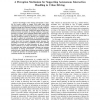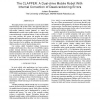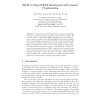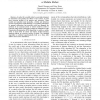265 search results - page 4 / 53 » Learning to Drive and Simulate Autonomous Mobile Robots |
IROS
2008
IEEE
14 years 2 months ago
2008
IEEE
Abstract— Knowledge of the driving environment is essential for robotic vehicles to comply with traffic rules while autonomously traversing intersections. However, due to limite...
ICRA
1994
IEEE
13 years 11 months ago
1994
IEEE
This paper presents a new approach to accurate and reliable dead-reckoning with mobile robots. The approach makes use of special properties of our recently developed Multi-Degreeo...
ICANNGA
2009
Springer
14 years 2 months ago
2009
Springer
In this paper we present application of genetic programming (GP) [1] to evolution of indirect encoding of neural network weights. We compare usage of original HyperNEAT algorithm w...
ICRA
2008
IEEE
14 years 2 months ago
2008
IEEE
— In order for a mobile robot to accurately interpret its sensations and predict the effects of its actions, it must have accurate models of its sensors and actuators. These mode...
ISER
1993
Springer
13 years 11 months ago
1993
Springer
The interaction of an autonomous mobile robot with the real world critically depends on the robots morphology and on its environment. Building a model of these aspects is extremel...




